-
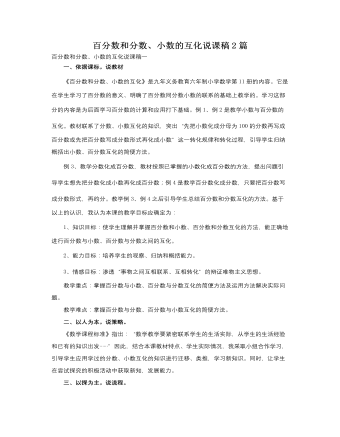
人教版新课标小学数学六年级上册百分数和分数、小数的互化说课稿2篇
二、以人为本,说策略。《数学课程标准》指出:“数学教学要紧密联系学生的生活实际,从学生的生活经验和已有的知识出发……”因此,结合本课教材特点、学生实际情况,我采取小组合作学习,引导学生应用学过的分数、小数互化的知识进行迁移、类推,学习新知识。同时,让学生在尝试探究的积极活动中获取新知,发展能力。三、以探为主,说流程。课堂教学是学生数学知识的获得、技能技巧的形成、智力、能力的发展以及思想品德的养成的主要途径。为了达到预期的教学目标,我对整个教学过程进行了系统地规划,遵循目标性、整体性、启发性、主体性等一系列原则进行教学设计。设计了以下几个主要的教学程序:(一)设疑激趣,引入课题。“兴趣是最好的老师”,为了激发学生的学习兴趣,课一开始,我设计了一个童话故事,在故事中设计了帮助主人公比较2/5、42%、0.45的问题,然后引出课题。
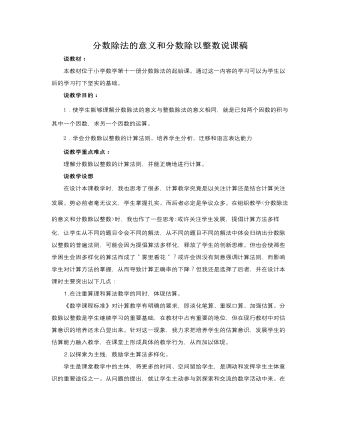
人教版新课标小学数学六年级上册分数除法的意义和分数除以整数说课稿
师:这是一种较为简便、应用广泛的方法,但有时候也要具体问题具体分析,做题时要合理灵活地选择计算方法。《研究学生如何学比研究教师如何教更重要。学生对新知识的学习必须以已有的知识和学习经验作为基础,因此正确分析学生的知识基础和学习经验就显得格外重要。我认为分数除以整数的教学基础在于以下几点:分数与小数的转化;分数的意义;分数乘法的意义;倒数的知识;商不变的性质等。这些知识在以前的学习中,学都有了足够的掌握。有了上面的分析基础,我觉得把研究新知识的权力教给学生,是完全可以的。》4、质疑与反思。师:对于这些方法,尽管大家的思维角度不尽相同,但是基本的想法是相同的,想一想我们是怎样解决问题的?生:用学过的倒数、商不变的性质解决的。师:对。用一句话概括就是运用旧知识解决新新问题。这是一种很重要的学习方法。5、实践体验练习巩固。
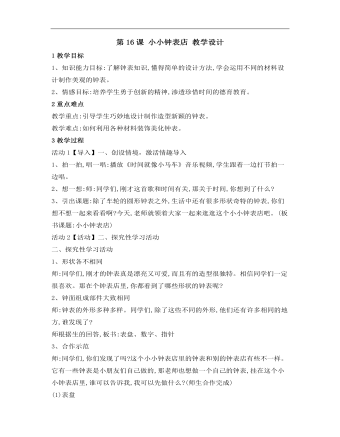
小学美术桂美版三年级上册《第16课小小钟表店1》教学设计说课稿
3教学过程活动1【导入】一、创设情境,激活情趣导入 1、拍一拍,唱一唱:播放《时间就像小马车》音乐视频,学生跟着一边打节拍一边唱。2、想一想:师:同学们,刚才这首歌和时间有关,那关于时间,你想到了什么?3、引出课题:除了车轮的圆形钟表之外,生活中还有很多形状奇特的钟表,你们想不想一起来看看啊?今天,老师就领着大家一起来逛逛这个小小钟表店吧。(板书课题:小小钟表店)
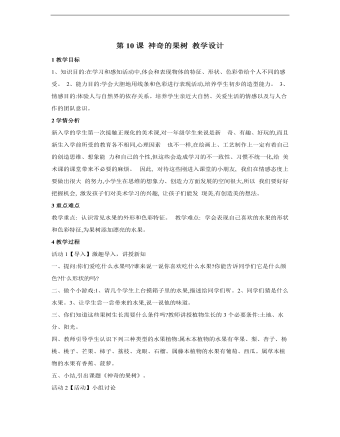
小学美术桂美版一年级上册《第10课神奇的果树》教学设计说课稿
2学情分析 新入学的学生第一次接触正规化的美术课,对一年级学生来说是新 奇、有趣、好玩的,而且新生入学前所受的教育各不相同,心理因素 也不一样,在绘画上、工艺制作上一定有着自己的创造思维、想象能 力和自己的个性,但这些会造成学习的不一致性、习惯不统一化,给 美术课的课堂带来不必要的麻烦。因此, 对待这些刚进入课堂的小朋友, 我们在情感态度上要做出很大 的努力,小学生在思维的想象力、创造力方面发展的空间很大,所以 我们要好好把握机会, 激发孩子们对美术学习的兴趣,让孩子们能发 现美,有创造美的想法。
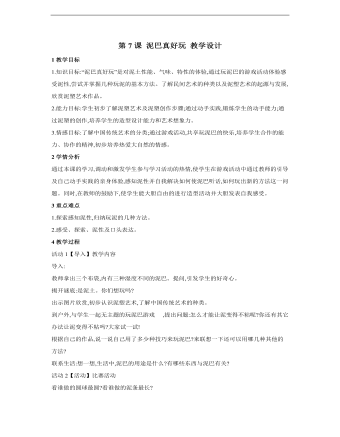
小学美术桂美版一年级上册《第7课泥巴真好玩》教学设计说课稿
2学情分析 通过本课的学习,调动和激发学生参与学习活动的热情,使学生在游戏活动中通过教师的引导及自己动手实践的亲身体验,感知泥性并自我解决如何使泥巴听话,如何玩出新的方法这一问题。同时,在教师的鼓励下,使学生能大胆自由的进行造型活动并大胆发表自我感受。3重点难点 1.探索感知泥性,归纳玩泥的几种方法。2.感受、探索、泥性及口头表达。
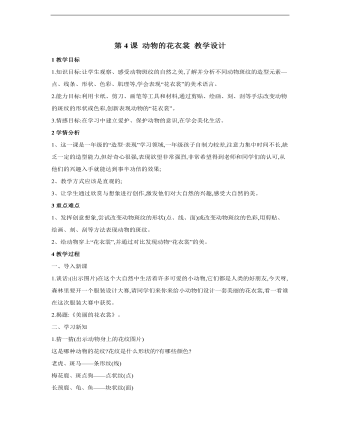
小学美术桂美版一年级上册《第4课动物的花衣裳》教学设计说课稿
2学情分析 1、这一课是一年级的“造型·表现”学习领域,一年级孩子自制力较差,注意力集中时间不长,缺乏一定的造型能力,但好奇心很强,表现欲望非常强烈,非常希望得到老师和同学们的认可,从他们的兴趣入手就能达到事半功倍的效果;2、教学方式应该是直观的;3、让学生通过欣赏与想象进行创作,激发他们对大自然的兴趣,感受大自然的美。
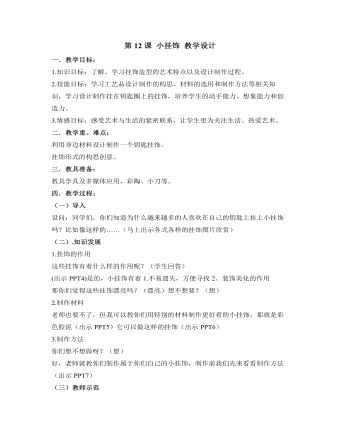
小学美术桂美版三年级上册《第12课小挂饰3》教学设计说课稿
二.教学重、难点:利用身边材料设计制作一个钥匙挂饰。挂饰形式的构思创意。三.教具准备:教具学具及多媒体应用,彩陶、小刀等。四.教学过程:(一)导入设问:同学们,你们知道为什么越来越多的人喜欢在自己的钥匙上挂上小挂饰吗?比如像这样的……(马上出示各式各样的挂饰图片欣赏)

小学美术桂美版三年级上册《第15课实用美观的竹器》教学设计说课稿
2学情分析本课内容选用了苗族阿姐的背篓,黎族阿爸的鱼笼,竹摇篮、簸箕等借助家庭中常见的竹器作为学习内容,目的是要求学生用线描的方法对竹器的外形及竹编的篾纹进行描绘,锻炼学生对事物的观察能力和表现能力。在此之前学生已经学过了如何用线描的方式描绘生活中的小物件,这为过渡到本课内容的学习起到了铺垫作用,同时为后面的素描教学内容打下造型基础。
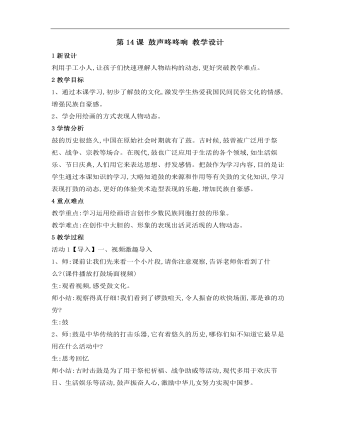
小学美术桂美版三年级上册《第14课鼓声咚咚响3》教学设计说课稿
3学情分析 鼓的历史很悠久,中国在原始社会时期就有了鼓。古时候,鼓曾被广泛用于祭祀、战争、宗教等场合。在现代,鼓也广泛应用于生活的各个领域,如生活娱乐、节日庆典,人们用它来表达思想、抒发感情。把鼓作为学习内容,目的是让学生通过本课知识的学习,大略知道鼓的来源和作用等有关鼓的文化知识,学习表现打鼓的动态,更好的体验美术造型表现的乐趣,增加民族自豪感。4重点难点 教学重点:学习运用绘画语言创作少数民族同胞打鼓的形象。教学难点:在创作中大胆的、形象的表现出活灵活现的人物动态。
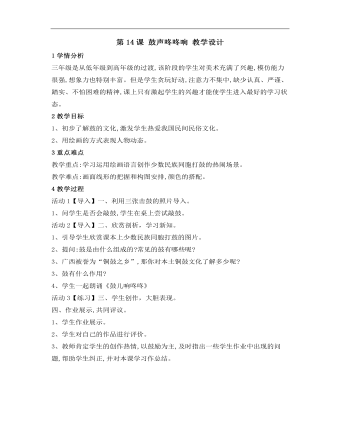
小学美术桂美版三年级上册《第14课鼓声咚咚响1》教学设计说课稿
2教学目标1、初步了解鼓的文化,激发学生热爱我国民间民俗文化。2、用绘画的方式表现人物动态。3重点难点教学重点:学习运用绘画语言创作少数民族同胞打鼓的热闹场景。教学难点:画面线形的把握和构图安排,颜色的搭配。
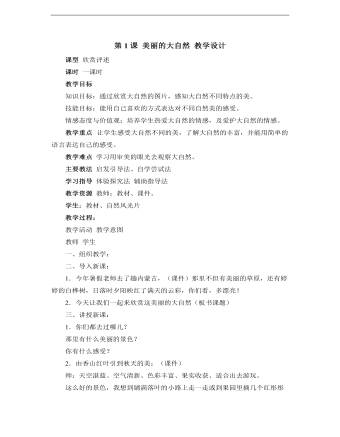
小学美术桂美版一年级上册《第1课美丽的大自然》教学设计说课稿
教学目标 知识目标:通过欣赏大自然的图片,感知大自然不同特点的美。 技能目标:能用自己喜欢的方式表达对不同自然美的感受。 情感态度与价值观:培养学生热爱大自然的情感,及爱护大自然的情感。 教学重点让学生感受大自然不同的美,了解大自然的丰富,并能用简单的语言表达自己的感受。 教学难点学习用审美的眼光去观察大自然。 主要教法启发引导法、自学尝试法 学习指导体验探究法辅助指导法 教学资源教师:教材、课件。 学生:教材、自然风光片 教学过程: 教学活动教学意图 教师学生
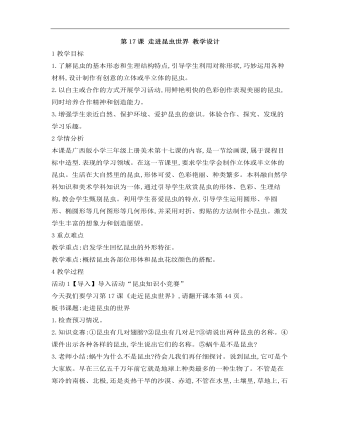
小学美术桂美版三年级上册《第17课走进昆虫世界》教学设计说课稿
2学情分析 本课是广西版小学三年级上册美术第十七课的内容,是一节绘画课,属于课程目标中造型.表现的学习领域。在这一节课里,要求学生学会制作立体或半立体的昆虫。生活在大自然里的昆虫,形体可爱、色彩艳丽、种类繁多。本科融自然学科知识和美术学科知识为一体,通过引导学生欣赏昆虫的形体、色彩、生理结构,教会学生甄别昆虫。利用学生喜爱昆虫的特点,引导学生运用圆形、半圆形、椭圆形等几何图形等几何形体,并采用对折、剪贴的方法制作小昆虫。激发学生丰富的想象力和创造愿望。
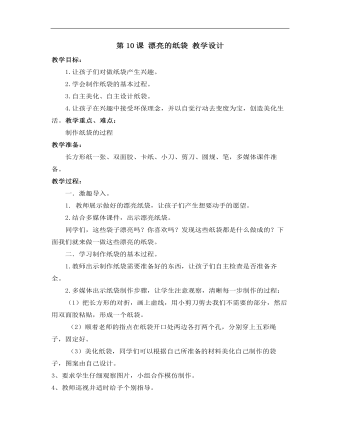
小学美术桂美版三年级上册《第10课漂亮的纸袋》教学设计说课稿
一.激趣导入。 1. 教师展示做好的漂亮纸袋,让孩子们产生想要动手的愿望。 2.结合多媒体课件,出示漂亮纸袋。 同学们,这些袋子漂亮吗?你喜欢吗?发现这些纸袋都是什么做成的?下面我们就来做一做这些漂亮的纸袋。 二.学习制作纸袋的基本过程。 1.教师出示制作纸袋需要准备好的东西,让孩子们自主检查是否准备齐全。 2.多媒体出示纸袋制作步骤,让学生注意观察,清晰每一步制作的过程: (1)把长方形的对折,画上虚线,用小剪刀剪去我们不需要的部分,然后用双面胶粘贴,形成一个纸袋。
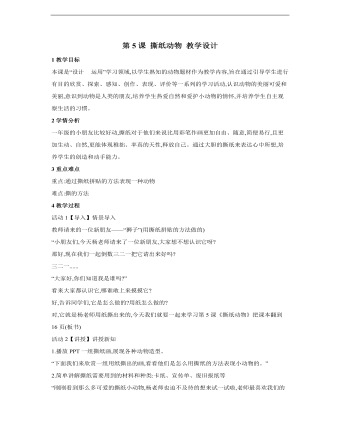
小学美术桂美版一年级上册《第5课撕纸动物》教学设计说课稿
2学情分析 一年级的小朋友比较好动,撕纸对于他们来说比用彩笔作画更加自由、随意,简便易行,且更加生动、自然,更能体现稚拙、率真的天性,释放自己。通过大胆的撕纸来表达心中所想,培养学生的创造和动手能力。3重点难点 重点:通过撕纸拼贴的方法表现一种动物难点:撕的方法

小学美术桂美版一年级上册《第6课送给老师的爱》教学设计说课稿
教学过程:一、组织教学,导入学习1.观察导入,激发兴趣(教具出示)2.教师和学生一起做猜节日的游戏,激发学生的兴趣。 每年的9月10日都是教师们最开心的日子,也是学生们表达对老师尊敬的日子,中国自古以来便有尊师重教的传统,《教师法》 第四条规定全社会应当尊重教师。
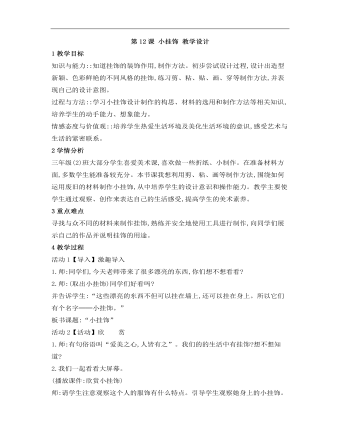
小学美术桂美版三年级上册《第12课小挂饰1》教学设计说课稿
2学情分析三年级(2)班大部分学生喜爱美术课,喜欢做一些折纸、小制作。在准备材料方面,多数学生能准备较充分。本节课我想利用剪、粘、画等制作方法,围绕如何运用废旧的材料制作小挂饰,从中培养学生的设计意识和操作能力。教学主要使学生通过观察、创作来表达自己的生活感受,提高学生的美术素养。3重点难点寻找与众不同的材料来制作挂饰,熟练并安全地使用工具进行制作,向同学们展示自己的作品并说明挂饰的用途。

新人教版高中英语必修2Unit 1 Cultural Heritage-Discovering Useful Structure教案二
This theme of the part is “ Describe people or things in greater detail”. Students have learned the grammar(restrictive relative clauses) in Book 1, and further review and consolidate its structure “prep+relative pronouns(which/whom)” and the relative adverbs(when, where and why), besides students should understand its form, meaning and functions. In this section, students should be able to express the grammar correctly in daily communication and in the writing. 1. Review the basic usages of relative pronouns and adverbs of attributive clauses . 2. Learn to use some special cases about restrictive relative clauses.3. Learn to write sentences with restrictive relative clauses flexibly according to the context.1. Review the basic usages of relative pronouns and adverbs of attributive clauses .2. Learn to use some special cases about restrictive relative clauses.3. Learn tow rite sentences with restrictive relative clauses flexibly according to the context.Step 1. Observe the following sentences, and mark the relative pronouns and the adverbs. 1. After listening to the scientists who had studied the problems, and citizens who lived near the dam, the government turned to the United Nations for help.2. Temples and other cultural sites were taken down piece by piece, and then moved and put back together again in a place where they were safe from the water.Step 2 PracticePlease complete these sentences with relative pronouns and relative adverbs and answer the following questions.Questions: 1. What is the head noun ?2. What relative words should be used ?3. What elements do they act in these sentences ?

新人教版高中英语必修2Unit 1 Cultural Heritage-Reading and Thinking教案二
1. This section focuses on "Understanding how a problem was solved”, which is aimed to guide students to analyze and discuss the challenges and problems faced by cultural heritage protection during the construction of Aswan Dam, as well as the solutions. On the basis of understanding, students should pay attention to the key role of international cooperation in solving problems, and attach importance to the balance and coordination between cultural heritage protection and social and economic development. Students are encouraged to face challenges actively, be good at cooperation, and make continuous efforts to find reasonable ways and means to solve problems.2. Enable students to understand the main information and text structure of the reading text;3. Motivate students to use the reading strategy "make a timeline" according to the appropriate text genre;4. Enable students to understand how a problem was solved;5. Enable students to understand the value of protecting cultural heritage by teamwork and global community;1. Guide students to pay attention to reading strategies, such as prediction, self-questioning and scanning.2. Help students sort out the topic language about protecting cultural relics and understand the narrative characteristics of "time-event" in illustrative style3. Lead students to understand the value of protecting cultural heritage by teamwork and global community;

新人教版高中英语必修2Unit 2 Wildlife Protection-Discovering Useful Structure教案二
2.表示现阶段正在进行的被动动作(该动作在说话的瞬间未必正在进行)。Many interesting experiments are being carried out these days.(说话时,并不一定正在进行)3.表示一种经常性的被动行为,常和always,constantly 等表示频度的副词连用,这种用法常常带有赞扬或厌恶的感情色彩。He is always being praised by the leader.4.表示按计划或安排主语将要承受谓语动词所表示的动作(仅限于少数及物动词)。A party is being held tonight.Step 4 Special cases1.像take care of, look after, talk about, think of等动词与介词构成的短语用于现在进行时的被动语态时, 其中的介词不可省略。The ways to stop illegally hunting are being talked about. 2.可与部分情态动词连用,表示对正在发生的事情的推测。She may be being punished by her mother.3.有时可表示按计划或安排将要进行的一个被动动作。A celebration is being held this weekend for his success.4.某些表示“状态、心理活动、存在”等的动词,如have,want,need,love,一般不用现在进行时的被动语态,而常用一般现在时的被动语态。With the population increasing,more land is needed.5.“be+under/in+n.”可表示现在进行时的被动意义。My computer is under repair.=My computer is being repaired.

新人教版高中英语必修2Unit 2 Wildlife Protection-Reading and Thinking教案二
The theme of this unit is human and nature, focusing on the theme of wildlife protection. Nature is a complex ecosystem, in which there are delicate balance between animals and plants. Because of the role of the food chain, the extinction of one species will produce influence, causing a series of chain reaction. Large scale extinction of species will have a serious and even irreversible impact on the ecosystem, resulting in immeasurable losses. Therefore, it is of great significance to protect wild species. To protect wild species is to protect human beings themselves. The motto of this unit is "when the buying stops, the killing can too,” which is a public service advertising slogan to protect wildlife. It tells people that every rhinoceros horn, every fur, every bowl of shark fin soup, every Ivory product, and every tiger bone product, etc. consumed by human beings, are innocent wild animals slaughtered behind them. The mission of wild aid is to ban illegal trade in endangered wildlife and mitigate climate change. It aims to educate the public to reduce the consumption demand for endangered wildlife products through public publicity and improve the awareness of environmental protection.1. Improve the awareness of wildlife protection by acquiring the knowledge of wildlife protection.2. Focus on environmental protection and protection of all lives.3. Analysis of the living environment of wild animals with appropriate thinking mode.4. Skillfully use the vocabulary and grammar knowledge of this unit to cultivate self-study ability according to the unit content5. Develop cooperative learning ability through discussion and other ways1. Enable the Ss to talk about the current situation of wild animals.2. Guide the Ss to summarize the main idea of each paragraph as well as the main idea of the text.